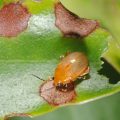The carabid beetle tribe Lachnophorini is the focus of an extensive new study by two Smithsonian entomologists just published in a special issue of the open access journal ZooKeys. The study reveals one new genus and a remarkable 24 new species added to the tribe.
Beetles from the family Carabidae, commonly known as ground beetles are a large, cosmopolitan group, with more than 40,000 species worldwide. Carabid beetles range in size from 0.02 to 3.5 inches and occur in nature in a wide variety of different environments as predators, ectoparasitoids, seed eaters, and even fungal feeders.

The newly described carabid species “Asklepia asuncionensis” (Photo Credit: Terry L. Erwin and Laura S. Zamorano)
“For a fairly large and diverse Tribe of Carabidae with interesting body forms and divergent ways of life, the Lachnophorini have all but been largely ignored by carabidologists until now,” says Laura Zamorano, a research entomologist at the Smithsonian’s National Museum of Natural History who is co-author of the study with Smithsonian entomologist Terry Erwin. “This new study establishes the groundwork for more refined studies aiming for a better understanding of the diversity of the species and the evolution of the tribe.”
Understanding the impact of this beetle family’s importance across a multitude of environments is a central challenge of the 21st century, the scientists say. Their work is the beginning of series of steps towards achieving a clear understanding of the taxonomic relationships between carabid beetles.
Original article: Erwin TL, Zamorano LS (2014) A synopsis of the tribe Lachnophorini, with a new genus of Neotropical distribution and a revision of the Neotropical genus Asklepia Liebke, 1938 (Insecta, Coleoptera, Carabidae). ZooKeys 430: 1-108. doi: 10.3897/zookeys.430.8094





